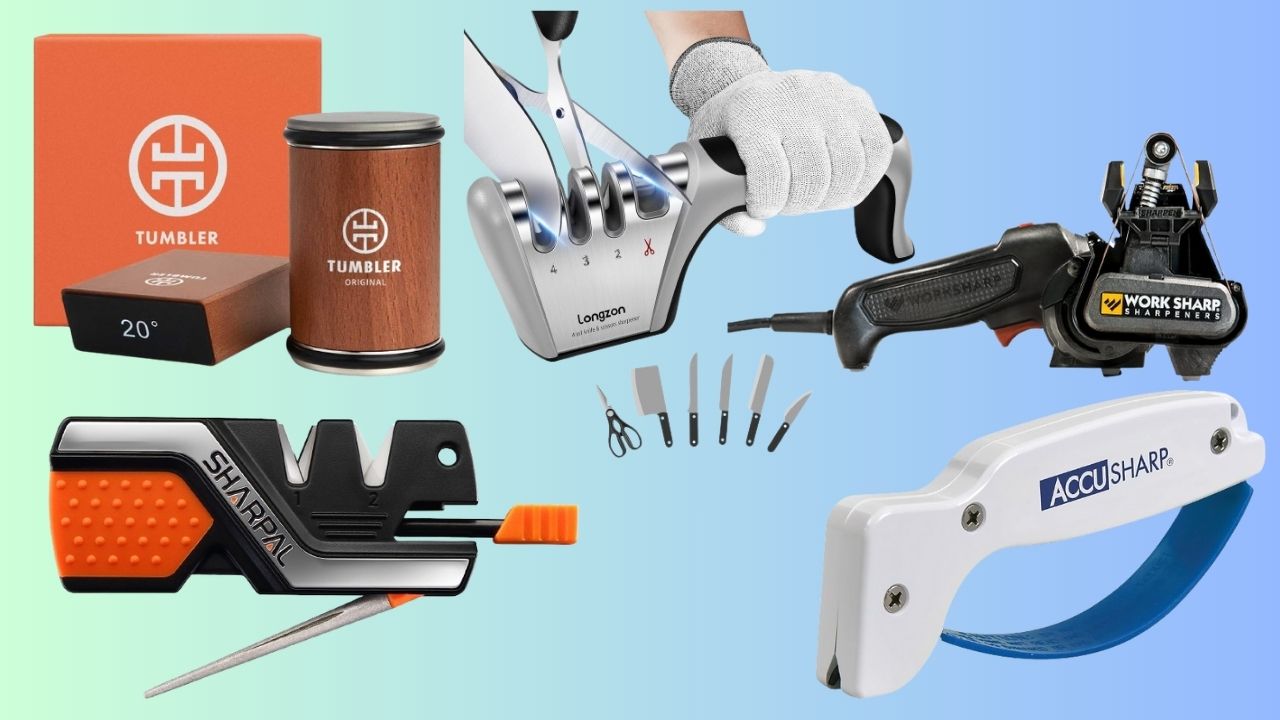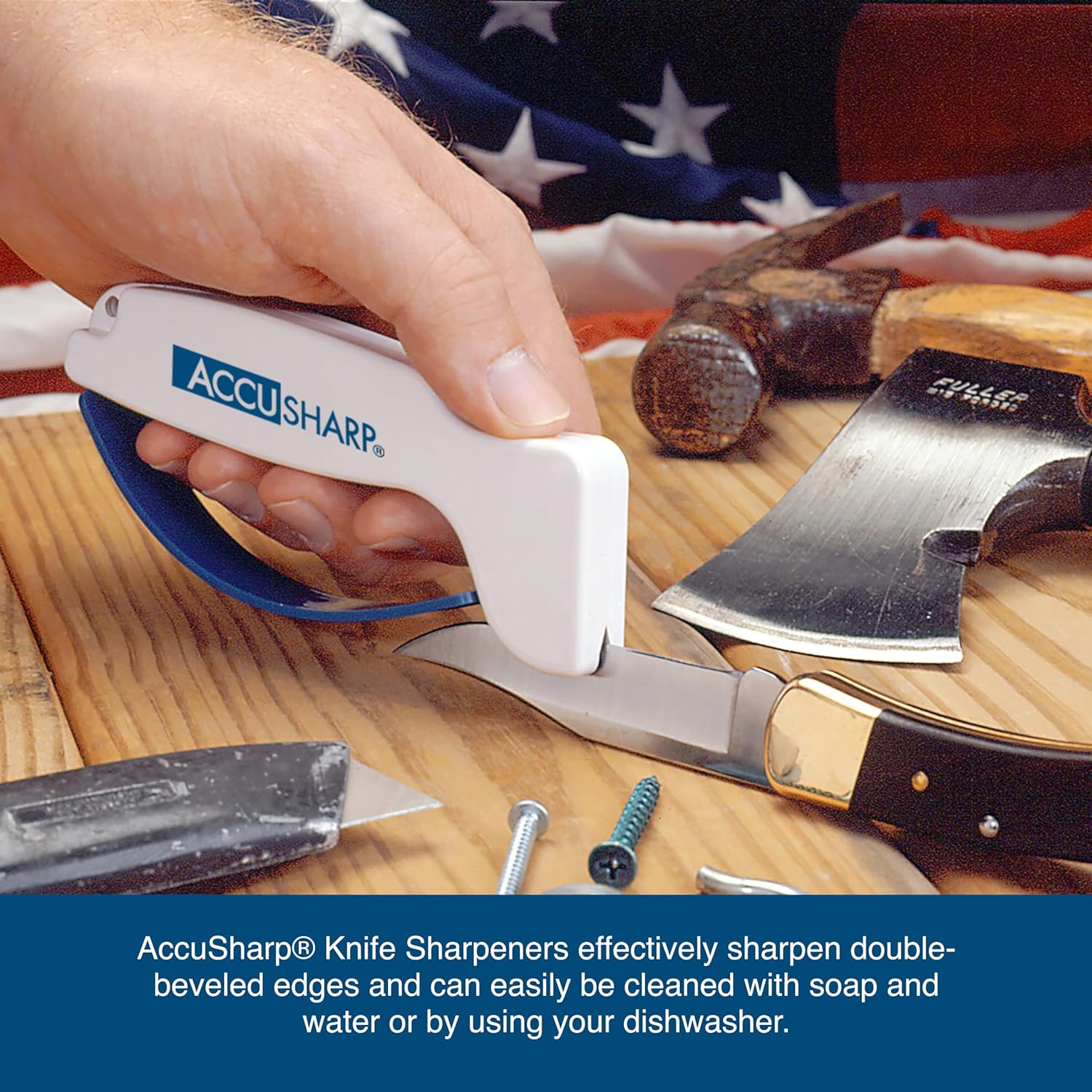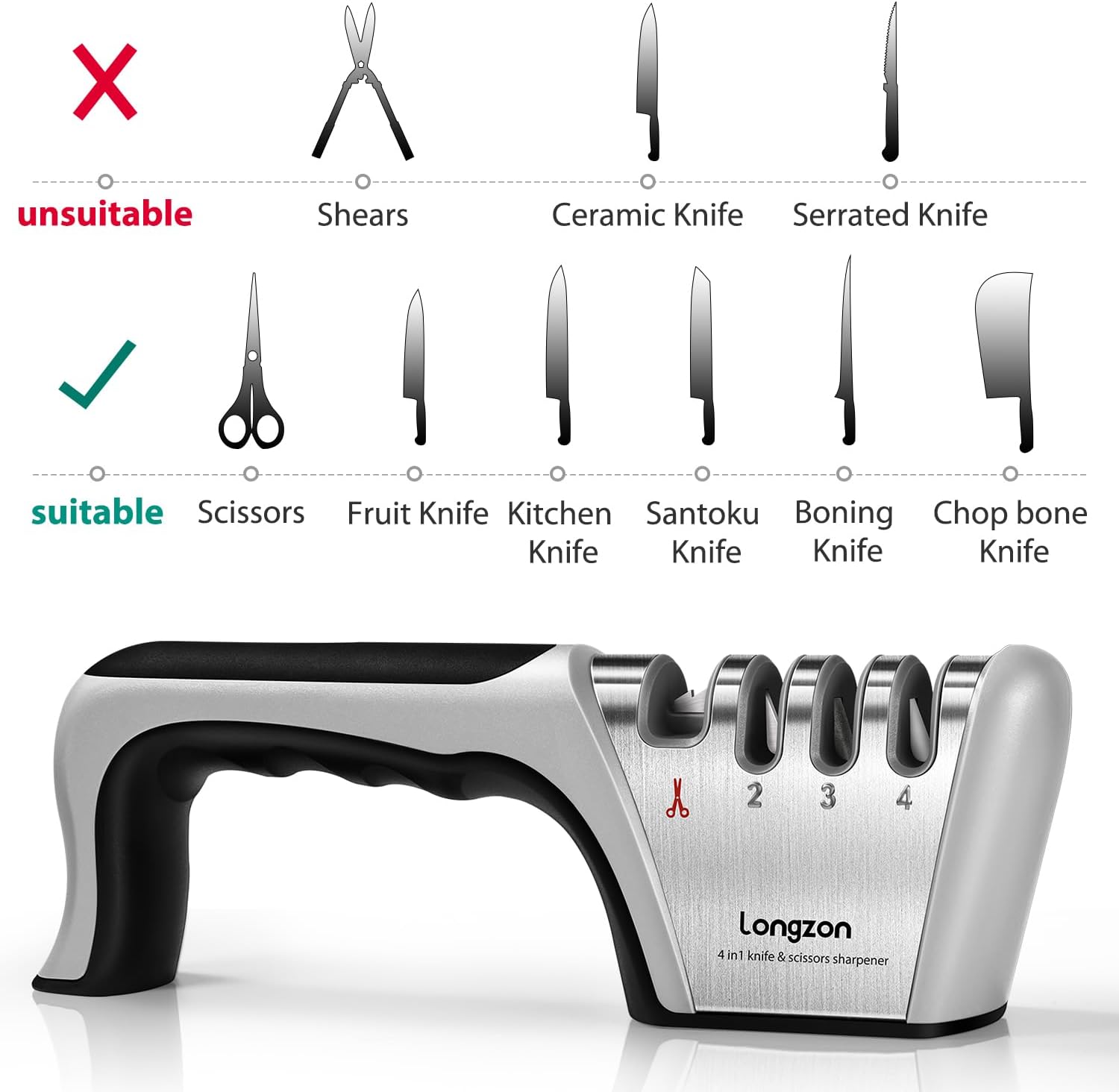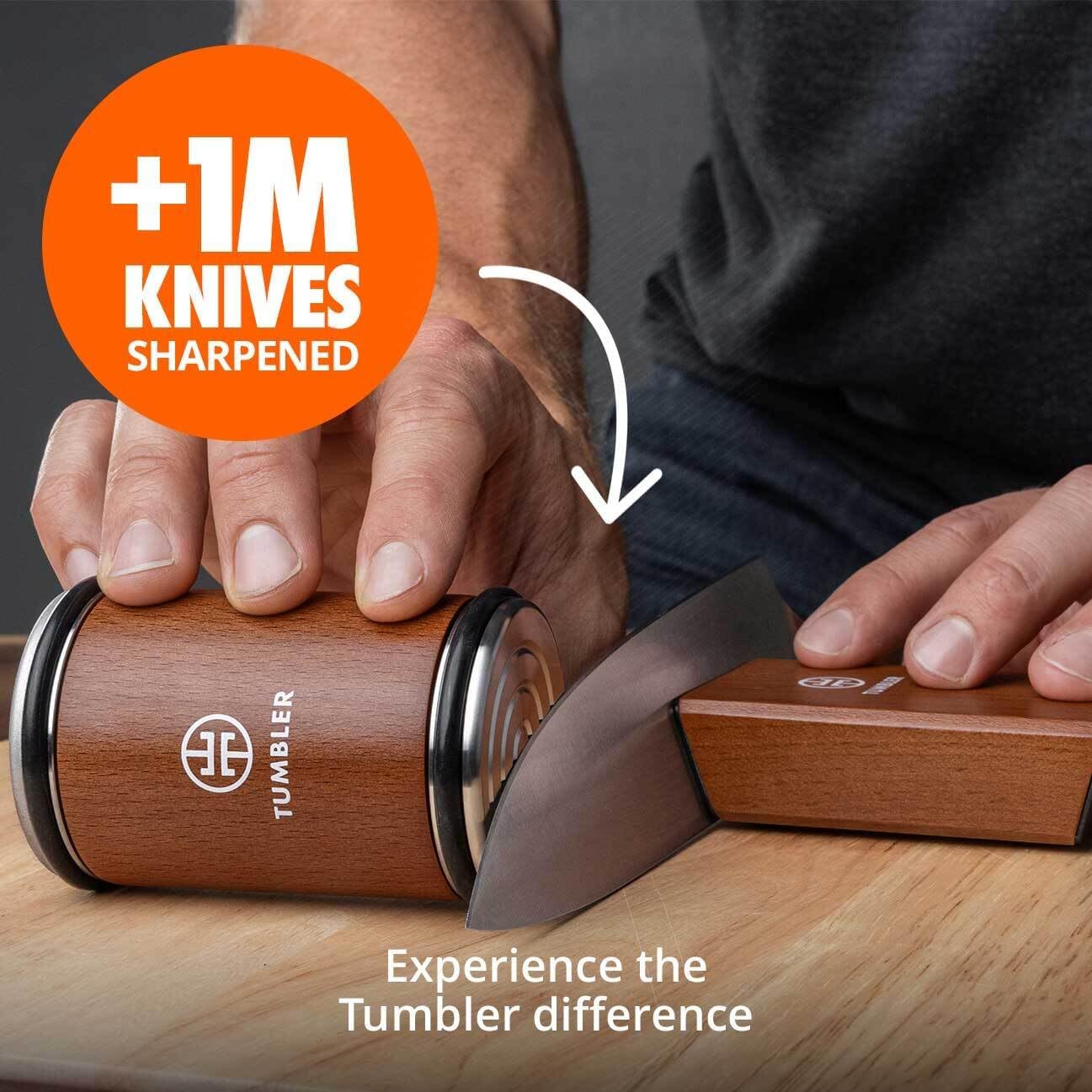Choosing the best knife sharpener can significantly enhance your kitchen experience, ensuring your knives maintain their edge and perform optimally. There are several types of sharpeners available, each catering to different needs and preferences.
Manual sharpeners, such as whetstones, offer precision and control, making them ideal for those who enjoy the art of sharpening. Electric sharpeners provide convenience and speed, making them perfect for busy kitchens. Pull-through sharpeners are user-friendly and suitable for quick touch-ups, while honing rods are essential for maintaining a knife’s edge between sharpenings.
When selecting a sharpener, consider factors like the type of knives you own (e.g., stainless steel, ceramic), your sharpening skills, and how often you cook. High-quality sharpeners often feature diamond-coated surfaces or ceramic rods for effective results. Look for models that provide adjustable angles, allowing for a customized sharpening experience.
Ultimately, the best knife sharpener will suit your specific needs, making meal prep safer and more efficient. Regular maintenance with the right sharpener not only prolongs the life of your knives but also enhances your culinary skills, turning cooking into a more enjoyable and rewarding activity.
Knife Sharpener
A knife sharpener is an essential kitchen tool that helps maintain the sharpness and functionality of knives, making food preparation safer and more efficient. Dull knives can lead to accidents and require more force to cut, which increases the risk of slips.
There are several types of knife sharpeners available. Manual options, such as whetstones, provide precision and allow users to customize sharpening angles, making them suitable for various knife types. Electric sharpeners offer convenience and speed, ideal for busy cooks who need quick results. Pull-through sharpeners are user-friendly and effective for quick touch-ups, while honing rods are designed to realign the blade’s edge between sharpenings.
When selecting a knife sharpener, consider the materials used—high-quality options often feature diamond or ceramic surfaces for optimal results. Additionally, think about your skill level and the types of knives in your collection.
Ultimately, a good knife sharpener not only prolongs the life of your knives but also enhances your cooking experience by ensuring your blades are always ready for use, making meal prep smoother and more enjoyable. Investing in the right sharpener is key to effective kitchen performance.
Our Picks: Best Knife Sharpener
1
Work Sharp MK2 Electric Knife and Tool Sharpener
The Work Sharp MK2 Professional Electric Knife Sharpener is a versatile sharpening system designed to enhance the performance of all your knives and tools. Building on the success of its predecessor, the MK2 introduces new features that streamline the sharpening process, making it faster, easier, and more consistent.
Equipped with flexible belts, this electric knife sharpener can achieve a razor-sharp edge for various blades, from kitchen knives to outdoor tools like lawnmower blades and axes. The belts adapt to the blade’s contours, ensuring effective sharpening for serrated knives and scissors as well.
A key feature is the adjustable sharpening guide, which helps maintain the correct edge angle, allowing users to quickly switch between 25° for outdoor knives and 20° for kitchen knives. The two-speed motor offers precision control for delicate tasks and sufficient power for heavier sharpening needs.
Additionally, the edge guide supports the knife throughout its length, enhancing ease of use. Proudly made by Work Sharp, a family-owned company in Oregon, this sharpener exemplifies quality and innovation, ensuring your tools are always in peak condition for any task.
2
AccuSharp Knife Sharpener
The AccuSharp Knife Sharpener is a compact and user-friendly tool designed to restore and hone both straight and serrated knives. Perfect for a variety of blades, including chef’s knives, paring knives, and cleavers, this sharpener is essential for any kitchen.
With the ability to sharpen most knives in around ten seconds, it significantly enhances efficiency and safety during food preparation. The sharpener features diamond-honed tungsten carbide blades, one of the hardest materials, ensuring a sharp edge with durability. The innovative design allows users to reverse the sharpening blades, effectively doubling their lifespan.
Constructed for long-lasting use, many users report needing blade replacements only every 5 to 10 years. The double-beveled sharpening system is also easy to clean, whether by hand or in the dishwasher.
Ergonomically designed, the AccuSharp fits comfortably in either hand, making it suitable for both right- and left-handed users. It includes a full-length guard that protects fingers during sharpening, ensuring a safe experience. Overall, the AccuSharp Knife Sharpener combines convenience, durability, and safety, making it a must-have tool for anyone who values sharp, reliable knives in the kitchen.
3
SHARPAL 101N Pocket Knife Sharpener
The SHARPAL 101N 6-In-1 Pocket Knife Sharpener & Survival Tool is a versatile and essential gadget for outdoor enthusiasts and everyday users alike. This compact tool combines multiple functions into one convenient design, making it perfect for hunting, camping, and kitchen use.
The sharpener features a V-notch slot with coarse carbide for quickly setting a new edge and a fine ceramic slot for honing a smooth finish. It also includes a tapered diamond rod, ideal for sharpening serrations and gut hooks, along with a specialized groove for fishhooks. Additionally, the integrated ferro rod provides a reliable fire-starting option, and the high-pitched emergency whistle ensures safety in the field.
Durability is key, with abrasives tested for over 10,000 uses, ensuring they won’t wear out. The sharpener is designed with a preset optimal sharpening angle, making it easy for anyone to achieve excellent results, whether for straight or serrated knives.
With a built-in lanyard hole, it’s easily portable, and the 3-year warranty reflects SHARPAL’s commitment to quality. Backed by superior after-sale service, the SHARPAL 101N is a reliable tool that guarantees a sharp edge whenever you need it.
4
Longzon Knife Sharpener
The Longzon 4-in-1 Knife Sharpener is a versatile and user-friendly tool designed to keep your kitchen knives in top condition. This sharpener features a four-stage process, allowing you to easily sharpen dull blades using a combination of tungsten steel, emery, high-hardness ceramics, and other durable materials, ensuring it lasts for over three years.
With three sharpening stages—coarse, medium, and fine—this sharpener effectively restores your knives to a professional-grade edge. It’s important to note that it’s not suitable for serrated knives, making it ideal for standard kitchen knives and scissors.
Ergonomically designed, the sharpener includes a non-slip rubber base and an easy-to-grip handle, ensuring stability and comfort for both right- and left-handed users. Its compact size makes it practical and straightforward to use; simply place the blade in the appropriate slot and pull it through a few times for quick results.
Longzon stands by their product with a no-worry 24-month warranty, offering refunds or replacements to ensure customer satisfaction. With excellent service and a commitment to quality, the Longzon 4-in-1 Knife Sharpener is a valuable addition to any kitchen.
5
Original Tumbler Rolling Knife Sharpener
The Original Tumbler Rolling Knife Sharpener™ is a revolutionary tool designed to make knife sharpening effortless and efficient. Ideal for kitchen knives, this sharpener offers precision sharpening at 15 and 20-degree angles, catering to both traditional and specialty blades.
Powered by diamonds, the sharpening kit features high-quality, diamond-plated surfaces that restore sharpness quickly and effectively. With a D35 grit size, it effortlessly revives the cutting edge of your knives, ensuring they perform like new for longer.
The design includes a proprietary stainless steel helix disc, which works to remove any burrs left on the blade after sharpening, providing a finer edge. Using the sharpener is straightforward: simply select your desired angle, secure your blade with the magnetic knife holder, and roll the sharpening disc back and forth until your knife is sharp.
Compact and user-friendly, the Tumbler Rolling Knife Sharpener is perfect for both home cooks and professional chefs who understand the importance of maintaining high-quality knives. With this tool, you can enjoy precise, long-lasting sharpness, making it an essential addition to any kitchen arsenal.
Benefits of Knife Sharpener
A knife sharpener is an essential tool that helps maintain the effectiveness and longevity of your knives. Here are some benefits:
Increased Efficiency: A sharp knife makes cutting, slicing, and chopping easier and faster, reducing the effort needed and improving precision.
Safety: Contrary to popular belief, a sharp knife is safer than a dull one because it requires less force, reducing the risk of slipping and causing injury.
Cost-Effective: Regular sharpening reduces the need to buy new knives as it prolongs the life of your existing knives.
Consistent Performance: Regularly sharpening your knives helps them maintain a consistent cutting edge, ensuring they perform optimally at all times.
Enhances Food Presentation: Sharp knives cut cleanly, leading to more aesthetically pleasing food presentation, particularly with delicate items like fruits, vegetables, and meats.
Ease of Use: Many modern knife sharpeners are easy to use, offering a quick way to sharpen without requiring special skills.
Selecting Points of a Knife Sharpener
When selecting a knife sharpener, it’s important to consider various factors to ensure you choose the right one for your knives and usage. Here are key points to consider:
1. Type of Knife Sharpener
Manual Sharpeners: These are handheld devices that you run the knife through. They’re usually simple, compact, and affordable. They are great for home use and are available in different grit levels.
Electric Knife Sharpeners: These are more advanced, using motorized wheels to sharpen the blade. They’re faster and often provide more consistent results but can be pricier and bulkier.
Sharpening Stones (Whetstones): Require more skill but provide a more precise and customizable sharpening experience. Ideal for those with a variety of knives and who want control over sharpening angles.
Honing Rods (Steel): These are not sharpeners per se but help maintain the sharpness by realigning the knife edge. Best for maintaining sharp knives in between sharpenings.
2. Sharpening Angle
Different knives require different sharpening angles. Most Western knives are sharpened at 20 degrees, while Asian knives often need a sharper 15-degree edge. Choose a sharpener that accommodates or allows adjustments for your knife’s angle.
3. Grit Levels
Knife sharpeners come in various grit levels:
Coarse Grit: Ideal for very dull or damaged knives to quickly restore the edge.
Medium Grit: For regular sharpening and maintaining sharpness.
Fine Grit: For polishing and finishing the blade to a razor-sharp edge. Having a sharpener with multiple grit levels allows you to address different sharpening needs.
4. Type of Knives You Own
Standard Knives: If you mostly have straight-edged knives, most sharpeners will work for you.
Serrated Knives: Some sharpeners aren’t designed for serrated edges, so if you have serrated knives, ensure the sharpener can handle them.
Specialty Knives: For ceramic or very high-end knives, you may need a specific sharpener designed for those materials.
5. Ease of Use
If you’re new to knife sharpening, opt for a sharpener that’s easy to use and doesn’t require much skill, like a manual or electric sharpener with preset angles.
6. Durability and Material Quality
A good sharpener should be made from high-quality materials, such as diamond, ceramic, or tungsten carbide, to ensure it will last and sharpen your knives effectively.
7. Safety Features
Look for features like non-slip grips, sturdy bases, and finger guards to protect your hands while sharpening.
8. Portability
If you need a sharpener you can easily store or take with you (e.g., for outdoor activities like camping), choose a compact manual sharpener or a portable sharpening stone.
9. Price
Entry-Level: Budget sharpeners may get the job done but might not last as long or provide professional-grade sharpening.
Mid-Range: You can find sharpeners that offer a balance between price and performance.
High-End: Premium sharpeners, like electric models or high-quality stones, may be more expensive but offer superior performance and durability.
By considering these factors, you can select the best knife sharpener for your needs and ensure your knives remain in top condition.
Care and Maintenance of a Knife Sharpener
Proper care and maintenance of a knife sharpener are essential to ensure its longevity and effectiveness. Here are some tips on how to care for and maintain different types of knife sharpeners:
1. Cleaning the Sharpener
Manual & Electric Sharpeners:
- After sharpening, small metal particles from the knife edge accumulate in the sharpener. Use a soft brush or cloth to remove these particles.
- If the sharpener has removable parts, disassemble them (if safe to do so) and clean them according to the manufacturer’s instructions.
- Wipe the exterior of the sharpener with a damp cloth. Avoid submerging electric sharpeners in water.
- For stubborn debris, use compressed air to clean the inside of electric sharpeners.
Sharpening Stones (Whetstones):
- After sharpening, rinse the stone with water to remove metal particles and excess oil (if oil is used).
- Use a brush or a dedicated stone cleaning solution to scrub the surface if the pores of the stone become clogged.
- Dry the stone thoroughly before storing it to prevent mold and damage.
2. Regular Maintenance
Sharpening Stones:
Over time, sharpening stones can become uneven from use. Use a flattening stone or lapping plate to level the surface regularly.
Store stones in a dry, cool place, especially those that are porous and may absorb water.
Electric Sharpeners:
If your electric sharpener has sharpening wheels, ensure they are not excessively worn. Some models may allow wheel replacements.
Unplug the sharpener and inspect it regularly for any signs of wear or damage to the components.
Honing Rods (Steel):
Clean honing rods periodically by wiping them down with a damp cloth or scrubbing gently with mild soap and water to remove accumulated metal residue.
3. Use Properly
Sharpening Angle: Make sure you are using the sharpener at the correct angle for your knife. For manual sharpeners, follow the guide slots. For sharpening stones, maintain the correct angle (usually 15-20 degrees) to avoid damaging your knife and the sharpener.
Pressure: Avoid using excessive pressure when sharpening, especially with electric sharpeners, as this can damage both the sharpener and the knife blade.
Avoid Overuse: Over-sharpening can wear down the sharpener’s abrasive surfaces or grinding wheels more quickly, shortening its lifespan.
4. Storage
Store your knife sharpener in a dry, clean environment to prevent rust or corrosion, especially for sharpening stones and honing rods.
Keep electric sharpeners in a place where they won’t be exposed to moisture or excessive heat.
For compact or portable sharpeners, use the protective cover or case they come with to prevent damage to the abrasive surface when not in use.
5. Inspect for Wear and Tear
Regularly inspect sharpening surfaces, such as the abrasive stones or belts on electric sharpeners, for signs of wear, cracks, or deterioration.
If your manual sharpener’s carbide or ceramic rods are chipped or no longer effective, replace them (if possible) or consider buying a new sharpener.
6. Avoid Contaminants
Never expose your sharpener to food particles or oils (unless using oil on whetstones) as they can degrade its performance over time.
For whetstones, use only the recommended type of oil or water. Mixing oil and water can clog the stone’s surface, reducing its effectiveness.
7. Lubrication (For Whetstones)
If you’re using oil stones, apply honing oil before sharpening to prevent metal particles from clogging the surface.
For water stones, soak them in water for 10-15 minutes before use and periodically re-wet them during sharpening to keep the surface lubricated.
By following these care and maintenance tips, your knife sharpener will remain in excellent condition, and you’ll ensure it consistently provides the best sharpening results for your knives.
Conclusion
A knife sharpener is an indispensable tool for maintaining the performance, longevity, and safety of your kitchen knives. By regularly sharpening your knives, you ensure that they remain efficient, precise, and safe to use. With various types of sharpeners available—manual, electric, stones, and rods—there’s an option to suit every level of expertise and knife type.
Proper care and maintenance of the sharpener, including regular cleaning, correct usage, and proper storage, further enhance its effectiveness and durability. Investing in the right knife sharpener and caring for it properly ensures that your knives remain sharp, reliable, and ready for any culinary task.
FAQs
1. How often should I sharpen my knives?
Answer: It depends on how often you use your knives. For regular home cooking, sharpening every 2-3 months is usually sufficient. Professional chefs or those using knives daily may need to sharpen more frequently. Honing, which realigns the edge, can be done more often—typically before or after each use.
2. What is the difference between sharpening and honing?
Answer: Sharpening removes material from the blade to create a new edge, while honing straightens and realigns the existing edge without removing metal. Sharpening is done less frequently, while honing can be done regularly to maintain the sharpness between sharpenings.
3. Which type of knife sharpener is best for beginners?
Answer: A manual pull-through sharpener is typically the easiest for beginners, as it usually has preset angles and is simple to use. Electric sharpeners are also user-friendly but can be more expensive. Whetstones require more skill but offer more precision.
4. Can I use a knife sharpener on serrated knives?
Answer: Not all knife sharpeners are designed for serrated knives. Some manual or electric sharpeners have a specific slot for serrated blades, but typically, serrated knives require less frequent sharpening. A sharpening rod or a specialized tool may be better for maintaining serrated edges.
5. Do electric sharpeners damage knives?
Answer: If used correctly, electric sharpeners won’t damage your knives. However, applying too much pressure or overusing the sharpener can wear down the blade faster than manual methods. Always follow the manufacturer’s guidelines to avoid unnecessary wear.
6. What sharpening angle should I use?
Answer: Most Western-style knives are sharpened at a 20-degree angle, while Asian-style knives typically use a 15-degree angle. Some sharpeners allow you to choose between these angles, while others have fixed angles. It’s important to match the sharpener to your knife’s angle for optimal results.
7. How do I know when my knife needs sharpening?
Answer: Signs that your knife needs sharpening include difficulty cutting, the blade slipping off food, or requiring more force to slice through ingredients. You can also test it by slicing through a piece of paper—if the knife struggles or tears the paper, it’s time for sharpening.
8. Can I sharpen ceramic knives with a regular knife sharpener?
Answer: No, ceramic knives require a special sharpener designed for the material, usually one that uses diamond abrasives. Regular sharpeners are meant for steel blades and won’t be effective on ceramic knives.
9. How do I care for my knife sharpener?
Answer: Clean your sharpener after each use by wiping away metal particles. For manual sharpeners, use a soft brush or cloth to clean the slots. Electric sharpeners should be unplugged and wiped down carefully, and sharpening stones should be rinsed and dried after each use. Proper storage in a dry place also extends the sharpener’s lifespan.
10. Can I over-sharpen my knife?
Answer: Yes, over-sharpening can wear down the blade unnecessarily, reducing the life of the knife. Sharpen only when necessary, and use honing to maintain the edge in between sharpenings.
11. Why does my knife feel dull after sharpening?
Answer: If your knife feels dull after sharpening, it could be due to improper technique or using the wrong sharpening angle. It’s also possible that too much material was removed, making the blade uneven. Using a finer grit or honing the blade after sharpening can help refine the edge.
12. Is a honing rod the same as a knife sharpener?
Answer: No, a honing rod (also called a sharpening steel) is used to maintain the knife’s edge by straightening it, not sharpening. It doesn’t remove material from the blade like a sharpener does, but it helps keep the knife aligned between sharpenings.








